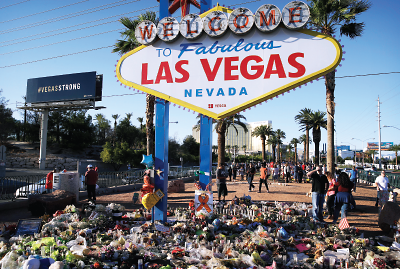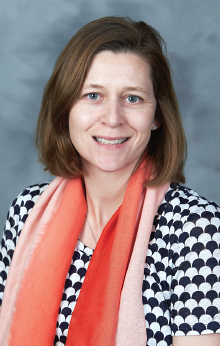Trauma of Las Vegas Shooting Likely to Show Up Weeks, Months Later
Abstract
Because many of the deceased and survivors of the shooting had come from many different places, the ripple effects of the shooting will be felt far beyond the tragedy’s epicenter.
She was working as a bartender at one of the concessions at a country music festival (call her “Ann”), and she must have been feeling optimistic—she had been clean and sober for several months after having been treated for an opioid addiction and might have been looking forward to a fun opportunity to make a little extra cash.

Flowers, candles, and other items surround a famous Las Vegas sign at a makeshift memorial for victims of last month’s mass shooting at a country music festival. Psychiatrists with expertise in trauma response say that reactions to the horrific tragedy may surface for some time to come.
But this was the Route 91 Harvest country music festival in Las Vegas, and at around 10:05 on the night of October 1, a hail of bullets came from the windows of the Mandalay Bay Hotel, which overlooked the festival grounds. Some 90 rounds were fired in a matter of minutes, leaving 58 dead and more than 500 injured—the worst mass shooting in modern American history.
“When the shots started, she was able to get out of the line of fire quickly and run,” said psychiatrist Lesley Dickson, M.D., executive director and a past president of the Nevada Psychiatric Association. Dickson had treated “Ann” using suboxone in a clinic that specialized in medication-assisted treatment. “She was from Las Vegas, so she had friends in town and was able to get home.”
First responders to the scene of the shooting were getting the wounded to nearby hospitals and directing those who fled the festival grounds to the Thomas and Mack Center, the basketball arena at the nearby University of Nevada, Las Vegas (UNLV), which became a temporary shelter. Fear and physical trauma were the acute symptoms.
But for Ann, symptoms of mental trauma appeared later. A week went by during which Ann was unable to sleep, haunted by memories of the killings. She started using pain pills again, and within days she was back at Dickson’s office seeking help.
“That’s the kind of thing I have been thinking about in relation to this shooting,” Dickson said. “We psychiatrists are second-line responders in a disaster such as this, waiting for these symptoms to percolate over time. We can expect these people to show up weeks or even months after the event with a story to tell, one they need to tell.”
Another critical aspect of the shooting to which psychiatrists everywhere should be alert is the nature of the event and its location—a concert featuring country music (always a popular draw) in Las Vegas, the nation’s resort town. Some 22,000 people were at the Route 91 Harvest, many of them from somewhere other than Las Vegas.
Grief, Distress Most Common Reactions to Expect
Joshua Morganstein, M.D., a member of the APA Committee on Psychiatric Dimensions of Disaster, emphasized unique aspects of the reaction that psychiatrists may see in patients affected by the Las Vegas shooting:
Most people are likely to experience distress reactions rather than a psychiatric disorder. Such reactions include insomnia, irritability, and decreased sense of safety as well as such health-risk behaviors as increased use of alcohol and tobacco for coping, and decreased travel in an attempt to feel safer. People with such reactions are more likely to be seen in primary care and emergency settings rather than in specialty mental health settings. Nonetheless, mental health professionals can help educate and remind primary and emergency providers that these reactions/behaviors may be related to disaster exposure and should be approached from that perspective.
Most people will ultimately recover to their baseline, and some may even develop a greater sense of efficacy in their ability to navigate stressful situations in the future. Early application of the principles of psychological first aid may reduce the risk of developing psychiatric disorders such as depression and posttraumatic stress disorder.
Grief will be the most universal experience of people impacted by the shootings—grief at the loss of loved ones, loss of safe spaces, loss of perceptions of feeling safe internally, loss of ability to see human beings as inherently good. An awareness of this near universal grief experience is an opportunity to support patients and enhance their social connectedness, which benefits not only patients but the community at large.
That means this is a trauma whose ripple effects will be felt by survivors and family members of the deceased in many parts of the United States and Canada, for weeks and months to come. “Most of the people affected were from out of state,” Dickson said. “If you look at a map of the deceased, they were from everywhere in the country, some as far away as Maine.”
It’s true—a Google search for a random selection of the names on the list of deceased released by the Clarke County Coroner’s office revealed that concert goers had traveled to the festival from locations as diverse as Shippensburg, Pa., Anchorage, Alaska, and Camarillo, Calif.
That fact created its own special kind of chaos on the ground in the aftermath of the shooting: many of those who had traveled long distances to Las Vegas had cars parked around the city that they could not get into because the police had locked everything down in the immediate aftermath of the shooting. Others had fled the shooting scene, losing wallets and/or cell phones. Still others who were working in the hotels and casinos at the time of the shooting were not allowed to leave for many hours. “One of our regular patients who works in the Mandalay Bay was stuck there until 6 the next morning,” Dickson said.
In what has turned out to be a disaster-filled season, APA’s Committee on Psychiatric Dimensions of Disaster has reached out to psychiatrists in Nevada after having responded to district branches impacted by the devastating hurricanes in Houston, Florida, and Puerto Rico. (At press time, the committee was also reaching out to district branches impacted by the fires in Northern California. More information on that response will appear in a future issue.)
“The committee has provided disaster education resources and outreach directly to our Area and Assembly reps as well as district branch leadership in Nevada,” said committee member Joshua Morganstein, M.D. “We have also provided consultation and resources to the National Association of State Mental Health Program Directors—these have been disseminated to their Nevada state director and her team as they will be very active in the response and recovery efforts” (see sidebar).
He is a captain in the U.S. Public Health Service and assistant director of the Center for the Study of Traumatic Stress at the Uniformed Services University of the Health Sciences in Bethesda, Md.
Morganstein, too, emphasized, the likely widespread sequelae of the Vegas shooting. “The 20,000-plus individuals at this event will disperse around the country, perhaps the world, and take with them the impact of this disaster,” he told Psychiatric News. “This is truly a national disaster and an important reminder that the disaster community is often much broader than the geographic region in which it occurred.”

Alison Netski, M.D., says that some survivors felt guilt at not returning to the festival area to help other victims.
At 6 a.m. on the day after the shooting, Alison Netski, M.D., chair of psychiatry at UNLV School of Medicine, was at the University Medical Center level 1 trauma center assessing acute psychiatric needs. Working with the Nevada State Mental Hospital and nearby private hospitals, Netski and colleagues sought to transfer as many patients as possible to open up beds for shooting victims coming out of surgery.
She echoed Dickson in saying that psychiatry’s role would be more crucial in the days that followed. “Our focus became how to help the 22,000 people who were involved in this event and who might be experiencing trauma and symptoms days later,” she said.
Two days after the shooting, a nearby outpatient UNLV clinic was opened for free counseling—“to all comers,” Netski said. While this service couldn’t be supported indefinitely, of course, Netski said the department established a foundation to accept donations from the community to offset financial barriers to receiving care for people who had been at the shooting or their family members.
“People express the unspeakable fear and helplessness they experienced seeing individuals gunned down right next to them,” Netski said. “There have been quite a number who have expressed survivor guilt. They will say, ‘I should have gone back to help her get out.’ ”
What commonly runs through the stories of all of the survivors of the Las Vegas shooting, where the perpetrator is reported to have used a semi-automatic rifle outfitted with a device to cause it to fire like a machine gun—is the rain of gunfire.
“Universally, people say, ‘Every time I close my eyes, I hear the gunshots,’” Netski said. “I have one patient who said, ‘The only way I can describe it is that it felt like we were being hunted.’ ” ■



